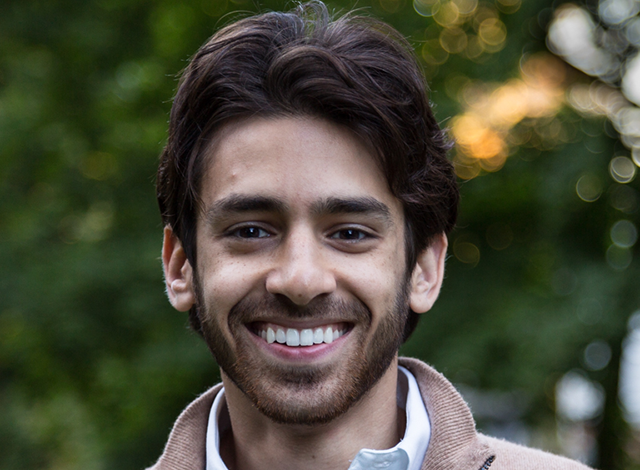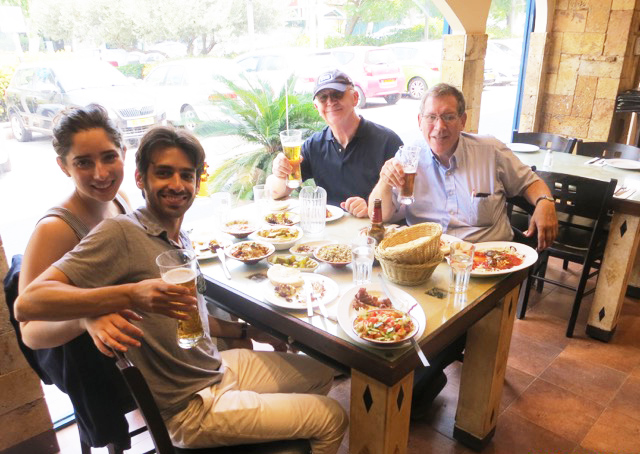At 29, Eran Hodis has achieved what many scientists dream of accomplishing in a lifetime: He discovered two of the most common genetic mutations in all of cancer. His work has global implications and could, in the future, lead to more effective cancer therapies. This year, in recognition of his scientific achievements, Hodis was named to Forbes’s prestigious “30 under 30” list.
“Without a doubt, my Weizmann training made that possible,” said Hodis, who earned his master’s in bioinformatics at Weizmann’s Feinberg Graduate School.
Now an MD-PhD candidate at Harvard Medical School and the Massachusetts Institute of Technology (MIT), he credits the Weizmann Institute – and in particular, his mentors Profs. Eran Segal and Joel Sussman – with launching his scientific career.

Feinberg Graduate School alum Eran Hodis. Photo by Moti Hodis
A Formative Summer
Born in Israel and raised in Framingham, Massachusetts, Hodis describes himself as “incredibly curious.” As an undergraduate at Boston University, he studied mathematics and biochemistry/molecular biology, and was interested in bringing these subjects together by pursuing computational biology. However, it was a summer program at the Weizmann Institute after his junior year that set him on a path to making science his life’s work.
As a participant in Weizmann’s Karyn Kupcinet International Science School for Overseas Students, Hodis was invited to take part in a collaborative project led by Prof. Gideon Schreiber in the Department of Biological Chemistry and Prof. Sussman in the Department of Structural Biology. The project entailed creating a piece of software to visualize 3D models of protein structures. “My role wasn’t exactly research,” Hodis explained, “but it was a first step of bringing me into the scientific community.” Using his computer programming skills, Hodis helped create a tool that produces molecular animations, which led to his first lead-authored paper.
After that, he was hooked. “I had always enjoyed learning, but I wasn’t sure what it meant to contribute to wider scientific knowledge,” he said. “My first summer in Joel Sussman’s lab was a formative experience.”
Joining “the Weizmann Family”
Hodis returned to Prof. Sussman’s lab the following summer, before beginning his master’s at the Feinberg Graduate School. The two developed a friendship that exists today. He describes Prof. Sussman as both “very intelligent and incredibly kind” – a scientist whose contributions to the field were praised at international conferences, and a teacher known for his generosity. “I was talking to Joel recently and he told me that one of his postdocs was staying at his place while he looked for an apartment,” he laughed.
As a graduate student, Hodis found that this sense of camaraderie was part of the Weizmann ethos: “We were immediately brought in as members of the family.”
“Weizmann has this Israeli culture of openness that allows people to be blunt, ask hard questions, and give critical feedback,” he explained, “but it’s also very collegial.”
In addition to discovering a community of like-minded peers, Hodis found that the Institute’s beautiful, garden-like campus provided an “oasis” where he could “be alone with [his] thoughts.” He also found another mentor in Prof. Eran Segal. After a rotation in Prof. Segal’s lab, Hodis saw an opportunity to train with a pioneering computational biologist, and, he recalled, “We really clicked personally. I tried to absorb as much as I could from such a brilliant leader in the field.”
As part of Prof. Segal’s group, Hodis trained as a computational biologist and solidified his passion for scientific research. Working with Prof. Segal and then-postdoc Dr. Shalev Iskovitz (who now has his own Weizmann lab), he investigated the question of whether overlapping protein-coding sequences existed in our genomes. “I was spending the majority of my waking hours in the lab, but I was excited to come back every day,” he said. “It was a really good sign. It made me realize I wanted to do this.”

On a recent trip to Israel, Eran Hodis enjoyed lunch at a hummus restaurant in Rehovot with his girlfriend Sarah Sabshon, his longtime Weizmann collaborator Dr. Jaime Prilusky (left), and his mentor Prof. Joel Sussman (right).
From Rehovot to Cambridge
After completing his master’s, the logical next step for Hodis was to continue on at the Weizmann Institute as a PhD candidate. Six months into his doctoral program, however, he received the devastating news that his mother had been diagnosed with an aggressive cancer. He left Israel and returned to Boston to be near family.
Watching his mother struggle with cancer changed the direction of his career. “I knew, thanks to Weizmann, that I wanted to be a scientist,” he said, “Science for the sake of science is great, but I realized that I also wanted to work with patients and help advance treatment.”
He recognized that he could bring his Weizmann training in computational biology to bear as a cancer researcher. The timing was fortuitous, he explained, because “we were on the cusp of next-generation sequencing technologies” that would give scientists the tools to make significant discoveries. At MIT and Harvard’s Broad Institute, in Prof. Levi Garraway’s lab, Hodis analyzed data that helped identify problematic genetic mutations in melanoma cells. He eventually co-discovered two mutations that could contribute to the cells’ unrestricted growth. It was this groundbreaking work that landed him a spot on Forbes’s “30 under 30” list.
“It’s thrilling to be able to work on these types of projects,” he said, “and it’s satisfying that these discoveries are having an impact – that people are building on our work.”
When asked what the future holds, Hodis estimates another four years before he completes his MD-PhD, but ultimately, he hopes to have his own clinic and research lab. He also plans to pursue his newfound love of teaching; he now co-teaches a course in computational biology that he and a colleague created at Harvard College. Regardless of where his career takes him, he’s confident that the Weizmann Institute will remain a significant part of his life. He keeps in touch with his Weizmann colleagues and mentors, and visits the Institute whenever he’s in Israel. And he continues to draw on the skills and the values he learned in Rehovot.
“The Weizmann Institute taught me how to think about fundamental questions,” he said. “We will find applications, but in order to get there, you first have to ask the questions that tickle your curiosity.”
